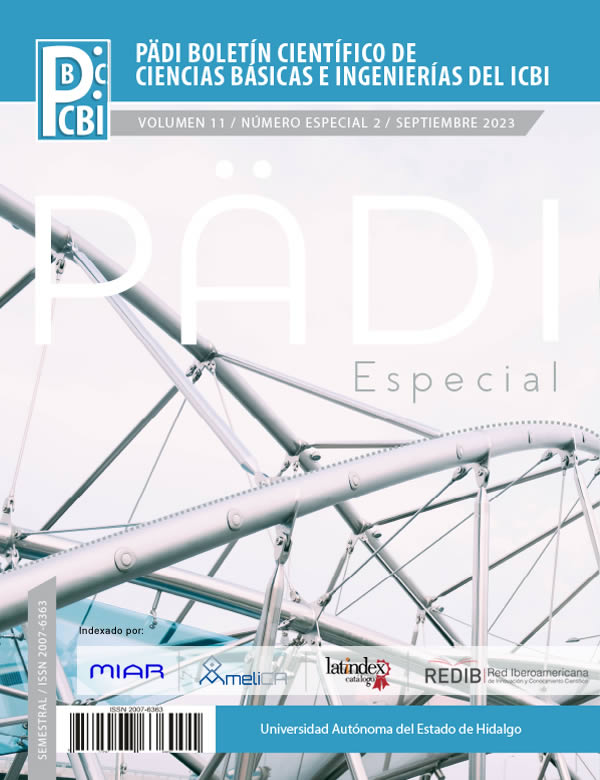Regulación de energía de un vehículo submarino no tripulado
DOI:
https://doi.org/10.29057/icbi.v11iEspecial2.10875Palabras clave:
Regulación de energía, inyección de amortiguamiento, oscilaciones, vehículo submarino autónomo, teoría de LyapunovResumen
Recientemente, la regulación de energía se introdujo como un nuevo objetivo de control para robots manipuladores, basado en un enfoque de moldeo de energía más inyección de amortiguamiento. En el presente trabajo, este reciente enfoque se aplica para lograr regulación de energía de un vehículo autónomo submarino no tripulado (VAS). El controlador propuesto es diseñado utilizando inyección de amortiguamiento parcial para generar oscilaciones en el VAS a lo largo de los ejes de las propelas que lo
impulsan. El usuario puede establecer una frecuencia y una amplitud deseada a través de ganancias expícitas del controlador. Una ventaja del controlador propuesto es que requiere menos esfuerzo de control que un controlador de seguimiento de trayectoria con inyección de amortiguamiento total, lo que puede ser útil para minimizar el consumo de energía del VAS. Se muestran simulaciones numéricas en un modelo de VAS de seis grados de libertad totalmente actuado para ilustrar el desempeño del controlador propuesto.
Descargas
Información de Publicación
Perfiles de revisores N/D
Declaraciones del autor
Indexado en
- Sociedad académica
- N/D
Citas
Chen, Y., Zhang, R., Zhao, X., and Gao, J. (2016). Adaptive fuzzy inverse trajectory tracking control of underactuated underwater vehicle with uncertainties. Ocean Engineering, 121:123–133.
Cho, G., Li, J., Park, D., and Jung, J. (2020). Robust trajectory tracking of autonomous underwater vehicles using back-stepping control and time delay estimation. Ocean Engineering, 201:107131.
Donaire, A., J.G.Romero, and Pérez, T. (2017). Trajectory tracking passivitybased controlfor marine vehicles subject to disturbances. Journal of Franklin Institute, 354:2167–2182.
Fossen, T. I. (2011). Handbook of Marine Craft Hydrodinamics and Motion Control. Wiley, Hoboken.
García-Molleda, D., Sandoval, J., Coria, L., and Bugarin, E. (2022). Energy-based trajectory tracking control for underwater vehicles subject to disturbances with actuator partial faults and bounded input. Ocean Engineering, 246.
Guerrero, J., Torres, J., Creuze, V., and Campos, E. (2019a). Saturation based nonlinear pid control for underwater vehicles: Design, stability analysis and experiments. Mechatronics, 61:96–105.
Guerrero, J., Torres, J., Creuze, V., and Chemori, A. (2019b). Trajectory tracking for autonomous underwater vehicle: An adaptive approach. Ocean Engineering, 172:511–522.
Guerrero, J., Torres, J., Creuze, V., and Chemori, A. (2020). Adaptive disturbance observer for trajectory tracking control of underwater vehicles. Ocean Engineering, 200:107080.
Higuera, C., Sandoval, J., Coria, L., and Bugarin, E. (2022). An autonomous unmanned underwater control test vehicle: platform description and experiments. Journal of Mechanical Science and Technology, 36:395–405.
Jia, Z., Qiao, L., and Zhang, W. (2020). Adaptive tracking control of unmanned underwater vehicles with compensation for external perturbations and uncertainties using port-hamiltonian theory. Ocean Engineering, 209:107402.
Khalil, H. K. (2002). Nonlinear Systems. Prentice-Hall, Upper Saddle River, New Jersey, USA.
Mohan, S. and Kim, J. (2015). Coordinated motion control in task space of an autonomous underwater vehicle-manipulator system. Ocean Engineering, 104:155–167.
Perez, T., Donaire, A., Renton, C., and Valentinis, F. (2013). Energy-based motion control of marine vehicles using interconnection and damping assignment passivity-based control - a survey. 9th IFAC Conference on Control
Applications in Marine Systems The International Federation of Automatic Control, Osaka, Japan, pages 316–327.
Sahoo, A., S.Dwivedy, and Robi, P. (2019). Advancements in the field of autonomous underwater vehicle. Ocean Engineering, 181:145–160.
Sandoval, J., Kelly, R., Santibáñez, V., and Villalobos-Chin, J. (2022). Energy regulation of torque-driven robot manipulators in joint space. Journal of the Franklin Institute, 359:1427–1456.
Valentinis, F., Donaire, A., and Perez, T. (2013). Control of an underactuatedslender-hull unmanned underwater vehicle using port-hamiltonian theory. 2013 IEEE/ASME International Conference on Advanced Intelligent Mechatronics (AIM), Wollongong, Australia, pages 1546–1551.
Valentinis, F., Donaire, A., and Perez, T. (2015a). Energy-based guidance of an underactuated unmannedunder water vehicle on a helical trajectory. Control Engineering Practice, 44:138–156.
Valentinis, F., Donaire, A., and Perez, T. (2015b). Energy-based motion control of a slender hull unmanned underwater vehicle. Ocean Engineering, 104:604–616.




















